First Impressions of the Bernina B990
The Most Expensive Sewing Machine Ever Made & Trickle-Down Effects on the Rest of the Sewing Machine Industry
Bernina recently came out with their newest top-of-the-line sewing machine, the B990. I want to share my first impressions of the machine, which I have boiled down to 4 points.
(1) Bernina Learned Their Lesson from the 8-Series
Bernina’s previous top-of-the-line product was their line of 8-series machines (820, 830, 880, etc.). I don’t mean to offend anyone who owns a Bernina 8-series machine. If you are happy with your Bernina 8-series then I am happy for you, but you are a relatively rare case. The Bernina 8-series machines are notorious for being difficult to thread and difficult to use. The design is such that the user cannot visually confirm if the takeup lever is threaded properly. The bobbin loading system is unique and cool and exotic, but over-engineered. The Bernina 8-series machines lent themselves to user error and mass customer dissatisfaction, so much so that Bernina created a buy-back program designed for 8-series owners to trade in their 8-series for the more user-friendly Bernina-7 series.
Thankfully, Bernina learned their lesson from their 8-series line: they recognized the problems with the 8-series and eliminated them from the design of the B990. For example, Bernina kept the B9 Hook System from the 7-series instead of the over-engineered 8-series bobbin loading system. The way you thread the upper thread on the B990 is also reminiscent of the 7-series and not the 8-series.
Meanwhile, Bernina took the innovative spirit infused in the 8-series and channeled it into some of the awesome features on the B990:
*truly* automatic needle threader
Built-in stitch regulator
“Jumbo” decorative stitches
Incredible color touchscreen
Intuitive navigation
Ability to Scan and preview your designs
Largest embroidery field at 16.1" x 12"
Pinpoint laser
Automatic stitch plate recognition
I think Bernina hit a home run with the B990. It feels amazing to sew one and I think sewists will find many of the features on the B990 to be fun and useful. I am a big fan.
(2) (Throat) Space Race
Prior to the release of the B990, Janome held the title for home sewing machine with the largest throat space: the M6, M7, M8, and M17 all have 13.5 inches of throat space. Bernina one-upped Janome by half an inch and gave the B990 14 inches of throat space. Brother and Baby Lock are releasing a new machine later this year and I expect them to be competitive in the throat space race as well. For further perspective on how large these machine are becoming, Bernina’s Q16 longarm quilting machine has 16 inches of throat space. The Aurora 440, Bernina’s revolutionary top-of-the-line machine that came out 20 years ago, only had a throat space of 7.5 inches.
I see this as significant for 2 reasons.
First, manufacturers like Bernina and Janome have recognized the obvious, which is that sewists like machines with larger throat space. I know this to be true from personal experience, having sold hundreds and hundreds of sewing machines without ever meeting a sewist who regrets getting a machine with a larger throat. Only the inverse is true. Larger throat means better vision. Larger throat means better lighting. Larger throat means less wrestling with quilts and large swaths of fabric. Larger throats means larger footprint of machine, which results in superior touch and feel while sewing.
Secondly, as companies like Bernina, Brother, and Baby Lock strive to out-do the massive 13.5 inches of throat space that the Janome Continental M-series offers, the price of machines with large throat space is becoming less expensive. For example, Janome has not responded to the B990’s 14 inch throat by making a machine with a 15 inch throat. Instead, the released the Continental M6 at $3,999, which is $1,000 less than the Continental M7. That is a brand new machine with 13.5 inches of throat space for under $4,000. Incredible.
That’s all to say: while machines are getting larger and more expensive, it is simultaneously true that sewists can now get a machine with tons of throat space for less than ever. Here are some ballpark figures that are trickle-down result of the sewing machine industry’s race for more throat space:
The price of a pre-owned M7 should go down to about $3,500.
The price of a new Janome MC9450 (11 inches of throat space) should be around $3,000, while pre-owned Janome MC8900/8200/7700 (11 inches of throat space) should be somewhere between $1,200-$2,000.
And, as many people trade in their old 7-series Bernina machines (10-inch throat space) for the new B990, you should be able to get pre-owned B740’s for ~$3,000 (~$4500+ new), and pre-owned B710’s and B750’s for ~$2,500 depending on the accessories it comes with.
If any of you are interested in a machine with lots of throat space (10+ inches) and are open to pre-owned machines, I recommend you consider the following: Baby Lock Aria, Brother BQ2500, Bernina 710/740/750/770/790, Janome M7, Janome MC9400/9450, Janome MC6700, Janome MC8900/8200/7700. These are well-made, reliable machines that offer good value at a fair pre-owned price.
(3) Manufacturers Really Want People to Quilt in the Hoop
Sewing machine manufacturers really want people to start making quilts on their embroidery machine (AKA “quilting in the hoop”). Just as throat space is getting bigger, so are machines’ maximum embroidery hoop size. Janome pushed it with their most recent top-of-the-line sewing-embroidery combination machine, the Continental M17. Bernina is pushing it with the B990. Brother and Baby Lock will surely push it with their new top-of-the-line machine when it is released later this year.
Look at the product page for the new Bernina B990. Most of the pictures of the machine involve quilting in the hoop:
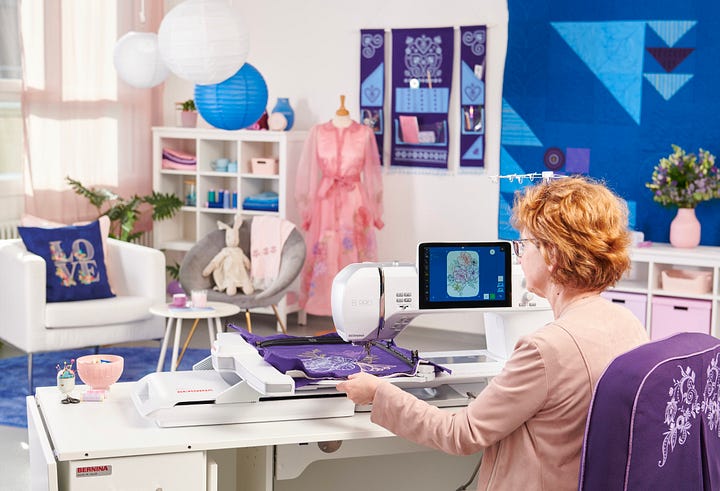
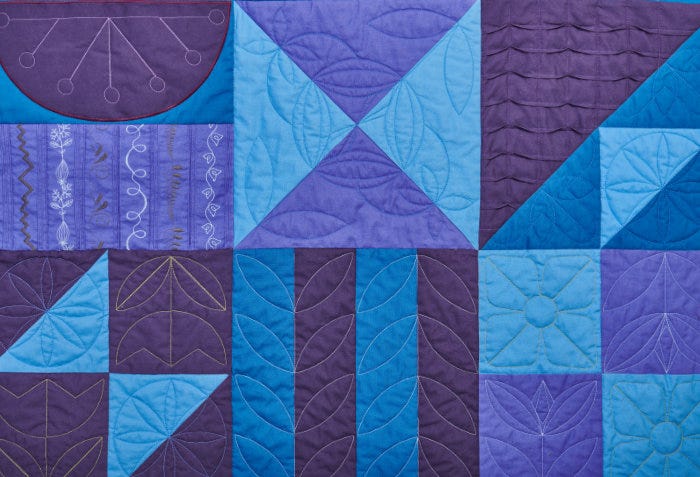
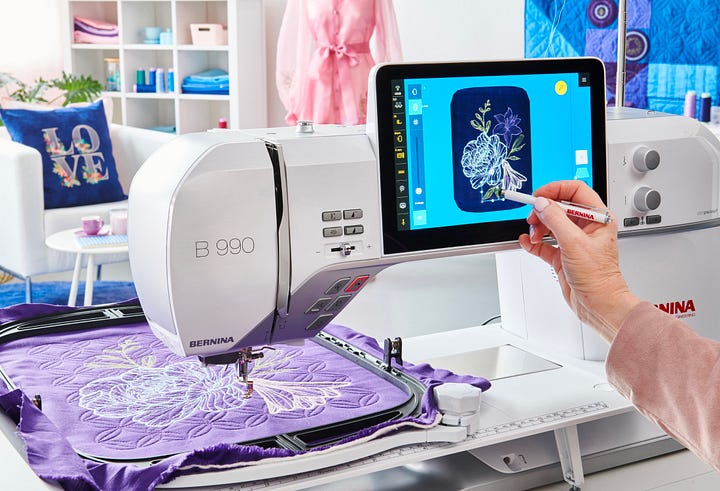
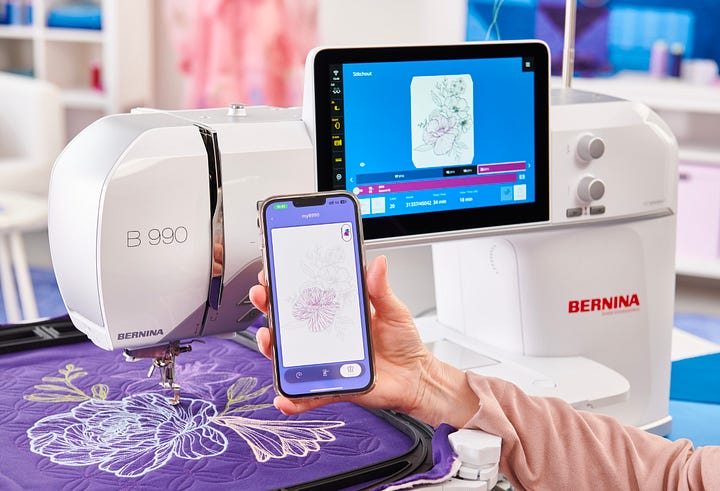
Why is this? Why do sewing machine manufacturers want people to fall in love with this new style of quilting? I think it’s an interesting question and deserves its own article, but I have a couple of quick ideas as to why:
One, it is a strategy to entice the next generation of sewists to take up quilting.
Two, a person who gets hooked on quilting in the hoop necessarily must own a more expensive machine. In other words, getting people hooked on quilting in the hoop is simply good for business.
(4) “I never thought I’d be selling sewing machines for as much as cars.”
My dad said this to me the other night and really gave me perspective on how far the home sewing machine industry has come in the past 30 years. The release of the B990 has ushered in an era where people are paying $20,000+ for a sewing machine. The vast majority of them are hobbyists, not sewing for business.
What exactly does this mean? I am not completely certain, so perhaps this is an article for another day, but I know that it means something, and I know that dealerships need to evolve accordingly. Exactly how to evolve, I am not sure yet. People love sewing so much that they deem a $20,000 sewing machine to be a worthy investment. As a sewing machine man, it gives me a lot to mull over.
Thank you for reading.
-Cale

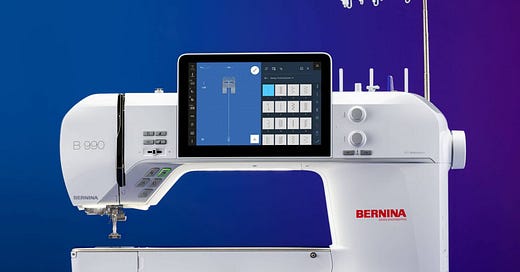


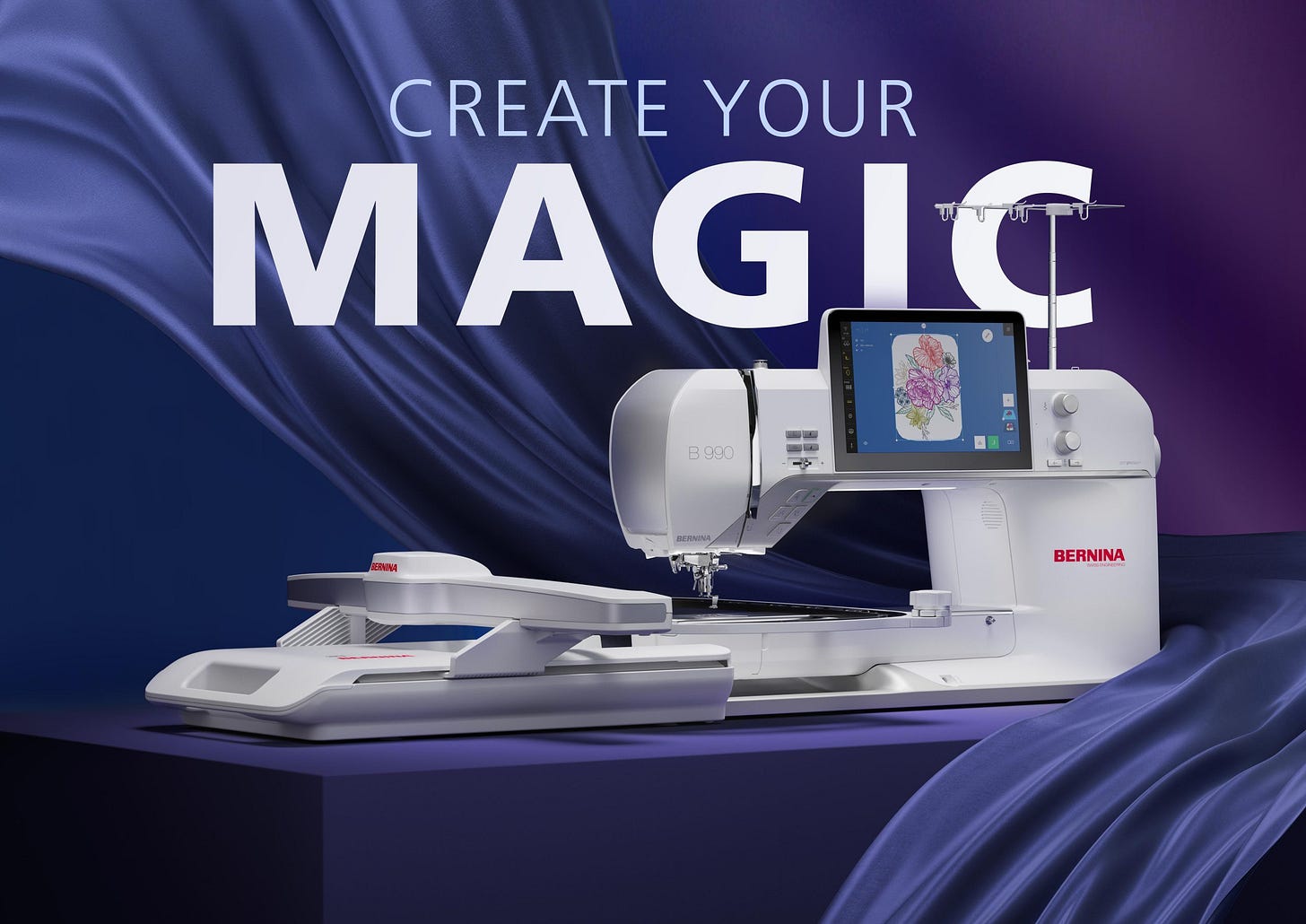

In Australia the Bernina B990 has a RRP of $22k, whereas the Janome Continental M17 is $25k. Until recently the latter was advertised at that price but is running out at the moment for $15-17k, so it would appear that Janome has something new on the horizon for this space. For sure, the B990 is a nice piece of kit but I recently decided that the B790 Pro is enough for me and I am delighted with my purchase. It is a dream machine. A common reaction to the price tag compares it to a car. My car was purchased 22 years ago for $25k and for the last 3 years it is driven once every 4-6 weeks. I only keep it around so that I can take my pets to the vet. I dislike driving and it's expensive to keep on the road. By comparison, over the last 20 years, I have spent more than that on my non-sewing hobbies. I sew nearly every day, so the purchase price of the sewing machine isn't as bad as it first seems. My Bernina Artista 180 is still going strong after 25 years. If I can get at least 20 years out of the B790, I will be happy.
About a year ago, I put aside my beloved Bernina to buy a Pfaff Creative 4.5, with quilting/embroidery function. Have to say I am sorry I made that transition as the Pfaff is overly complicated and I will never use ¾ of its functions. You also need bespoke bobbins, which means I can't use my 30+ Bernina bobbins in it. But I was prepared to give using the hoop to quilt a go . It's not easy and even seasoned sewists like me need plenty of instruction and education. And to answer your question about why sewing machine manufacturers are steering people into hoop quilting, I think it's because they must have stakes in thread companies, given how much thread one has to use in machine embroidery and quilting. Now I'm pondering how to sell and buy a Janome, after reading your terrific newsletters. No-one here in Australia accepts used machines as trade-ins any more, so we have to sell privately.